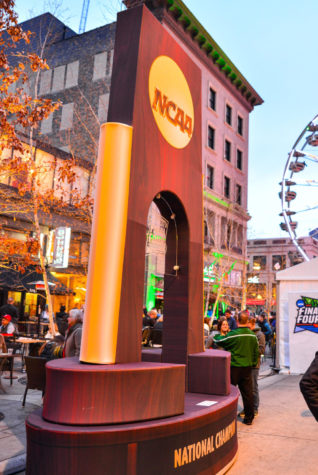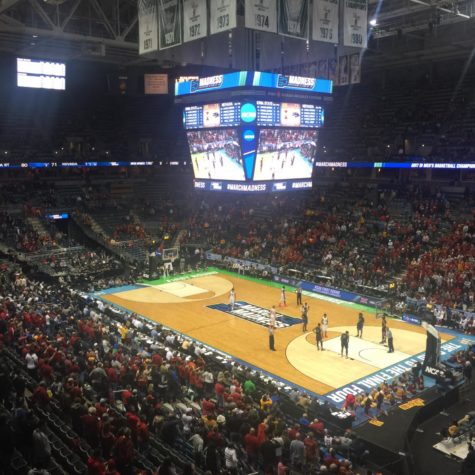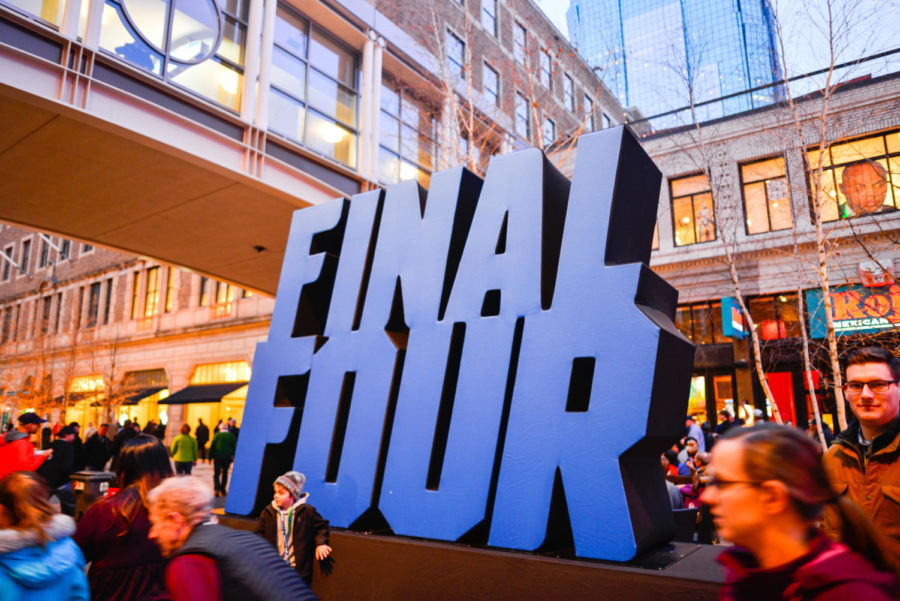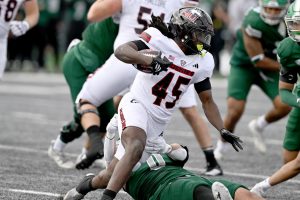Weight of words: the NCAA failed attempt to right its wrong
The inequality between NCAA Men’s and Women’s basketball stems far beyond the weight room
GettyImages
Minneapolis, MN, USA. 4/6/2019: Entertainment in Minneapolis, Minnesota for the NCAA Final Four Basketball Tournament on Nicollet Mall. Signage on the the street.
March 21, 2021
March is host to one of the largest annual sporting events in the U.S. For three and a half weeks the NCAA hosts its annual NCAA Men’s and Women’s National Championship Tournaments.
Fields of 68 teams for each tournament converge and compete in a single-elimination style bracket that culminates with one team surviving, earning the crown as National Champions.
The men’s tournament draws massive fanfare. More than 36.7 million brackets are projected to be filled out, and 47 million Americans are projected to bet on the tournament in some fashion, according to a survey from the American Gambling Association.

Paramount, the parent company to media mogul CBS, shows wire-to-wire coverage of every game on not just CBS, but all its sister stations like TNT, TruTV and TBS. This makes the broadcast organization and the NCAA almost an unquantifiable amount of exposure and ad revenue.
The NCAA men’s basketball tournament accounts for $800 million of the NCAA $1.1 billion in revenue, according to CBS Sports. Revenues are distributed to the NCAA 1268 member institutions.
The NCAA does not have a revenue problem, so when University of Oregon forward Sedona Prince released a TikTok video showing the facility conditions at the the NCAA women’s basketball tournament in San Antonio, Texas, it made me not just shake my head, but question what the governing body was thinking.
Prince showed in a 45-second TikTok that the NCAA provided one rack of dumbbells for the women’s weight room facility, while just 1200 miles north in Indianapolis, the host city of the men’s national tournament, the Ducks men’s team had an entire ballroom full of lifting and performance equipment to use for its time in the bubble.
It was more than just one team who took to social media to complain about the conditions for women’s basketballs’ biggest event.
“These women want and deserve to be given the same opportunities,” Stanford University Sports Performance Coach Ali Kershner said in an Instagram post. “Three weeks in a bubble and no access to (dumbbells) above 30’s until the sweet 16? In a year defined by a fight for equality this is a chance to have a conversation and get better.”
Kershner is right— this is a prime example that should be used to spark ongoing dialogue between the NCAA and its partners about equality, but is it a conversation the NCAA is serious about having?
Following the massive outcry on social media, the NCAA released a statement in part stating that some normal team amenities were not available due to “limited space,” but NCAA vice president for women’s basketball Lynn Holzman admitted Friday the organization “fell short” in preparing for the 64 teams to stay in San Antonio.
Prince released a second TikTok debunking the NCAA claim of lack of space showing large amounts of empty square footage in the women’s practice pavilion.
Though damages have been rectified. The NCAA Women’s Basketball Twitter account released a tweet Saturday with a photo of the bubble’s updated weight room, saying “The weight room has arrived! Let’s gooooo.”
Only after three days of a social media firestorm did the NCAA attempt at creating equal facilities for the two events.
Vice President Holzman, I agree with your statement. You and the NCAA have fallen short. You fell short not just on setting up adequate hospitality and training facilities for the best female athletes in basketball, but you and the NCAA have failed for a number of years at promoting equality between sexes within college athletics.
While the NCAA men’s tournament receives wall-to-wall coverage on CBS, TNT, TruTV, TBS and the March Madness app, you can watch the NCAA women’s basketball tournament on ESPN 2 and ESPNU. There’s also limited streaming capabilities on the NCAA March Madness app.

The men’s selection show is annually held in primetime on CBS, a national channel that everyone with TV receives. The NCAA women’s selection show was given a one-hour time slot at 7 p.m. ET on ESPN, a channel that requires a package other than basic cable.
It’s time for the NCAA to stop with the rhetoric of promoting equality among men and women’s athletics and for once take measurable action. Revenue cannot be the end-all be-all motivator when it comes to treating female athletes with the respect they deserve.
History has shown that the NCAA cares more about its bottom line than it does about showcasing the talents of its student-athletes or rewarding them in any way, if that means the organization has to dip into its own pockets.
We live in a time when the NCAA is suing in federal court to keep athletes from making money off their own name, image and likeness, while using the argument of not just receiving a world class education, but some of the best facilities athletics has to offer. The photos coming out of San Antonio make it seem like the NCAA has been talking out of its ass.
The tournaments will go on, the NCAA will make millions off the backs of all athletes competing, both male and female. Revenues will be distributed to universities, and the sad truth in this matter is we will all probably forget about this injustice after the confetti falls, which is exactly the problem.
The sports community cannot continue to enable an organization that sees female athletes as lesser pawns in its game of monopoly. Prince said it best in her TikTok — “If you’re not upset about this problem, then you’re a part of it.”
It’s time we all get upset and turn that frustration into solutions.








